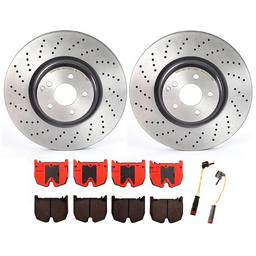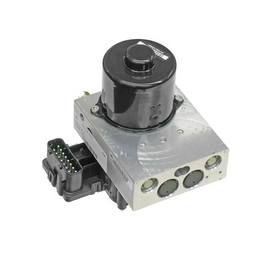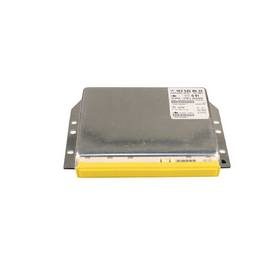The days when hydraulics were the be-all, end-all solution to automotive subsystems are slowly coming to an end. Steering was the first to switch to fly-by-wire technology, and despite a few faint complaints from the back of the classroom, everyone realized the benefits of this innovation. That being said, braking by wire technology such as the Mercedes Benz SBC was harder to swallow. We’ve all got too used to feeling the hydraulics work under our foot when we hit the brake pedal. How do electronic systems fit into that tactile world? As it turns out, going electronic has many perks.
Modern Braking Systems
We live in a world where 0-60 and quarter-mile times are all the rage. However, being able to bring the car to a standstill is arguably equally as important, if not more. Not only is it a matter of braking later before hitting the apex, which shaves off precious lap time, but it’s also a matter of safety.
Modern braking systems represent one of the last bastions of hydraulics in cars. Just about everything else has been taken over by electronics. Even so, various brands are slowly leaping the brake by wire territory. Mercedes Benz, as per usual, is one of the first brands to dabble in the arts of EBS with their SBC or Sensotronic Brake Control
Here’s the kicker – Mercedes launched this system all the way back in 2001.
Mercedes Benz SBC Brake By Wire System – The Basics
The Sensotronic Brake Control system represents the third evolution of electronic brake assist systems. It’s right up there with the ABS and ESP. In fact, both the ABS and ESP are partially integrated into the SBC, thus forming a higher level braking system.
The main advantage of Mercedes Benz SBC is improved efficiency. The system is capable of creating individual braking solutions for each wheel of the car. Vehicles fitted with SBC are capable of shorter stopping distances and improved braking stability under emergency conditions.
How Does It Work?
The whole system can be reduced to several main components. You have the actuator unit that’s linked to your brake pedal, the main control unit, and the ESP computer. These three components are complemented by a system of hydraulic lines that run to and from individual brakes.
It all starts with a push of a brake pedal.
One of the main concerns regarding electronic brake systems was the absence of pedal feedback. We’re tactile beings who largely depend on sensory feedback. Experiencing zero resistance when applying the brakes would leave us unable to figure out just how hard we should brake in the first place.
Mercedes Benz took care of that by installing a hydraulic simulator right behind the brake pedal. As a result, the brake pedal feel is there, and someone who doesn’t know about SBC would be none the wiser.
SBC Control Unit and ESP Computer
Once the pedal is pressed, the actuator sends the driver’s input parameters to the SBC control unit. SBC control unit is fitted with the main hydraulic high-pressure reservoir, a hydraulic pump right above it, a bunch of pressure sensors, hydraulic valves, and a computer unit that controls everything.
When the SBC control unit receives the input from the pedal, it sends the data to the ESP control unit. As it turns out, it was easier for Mercedes to use the ESP system than to devise a separate network of sensors to determine what each wheel is doing at any given time.
Once the ESP calculates a braking solution for the SBC, the data is returned to the main control unit, which then uses its numerous hydraulic valves to actuate each individual brake caliper accordingly.
Benefits of Mercedes Benz SBC
SBC and other electronic brake systems are often complex compared to their hydraulic counterparts. However, this increase in complexity brings a number of advantages that make the whole thing well worth the effort.
The use of an electric hydraulic pump means that the calipers are getting the fluid much faster in case of an emergency. The fact that so many electronic systems and their respective computer control units are involved means that you can enjoy things like preloading the brakes. The entire system can sense when the gas pedal is quickly released uses that split second to preload the hydraulic lines anticipating brake pedal actuation.
There’s plenty of little additional features that make the SBC such an effective system.
SBC Issues and Brake By Wire Safety
Although the ammunition to make a case for SBC and other brakes by wire technology is plentiful, some issues need to be mentioned. Mercedes Benz has had quite a rough ride with this system in various models made from 2004 to 2011. Several known issues ultimately led to a limited recall in the United States. The main problem is the SBC control unit failure that can happen due to a number of different reasons.
- Brake Fluid Replacement – One of the reasons why some SBC control units fail is a failure on the owner’s part to replace the brake fluid. Since the whole system is comprised of tiny hydraulic valves and actuators, any imperfection in the braking fluid could cause issues.
- Electrical Failure – Some units experienced an electrical failure that would render them inefficient at best, or completely ineffective at worst.
- The Magical 300,000 Brake Actuations Number – One of the absolutely most common issues that plague SBC systems is the 300,000 brake actuation limit imposed by Mercedes Benz. The company has deemed that 300,000 presses of the brake pedal warrant the control unit replacement.
Diagnosing Sensotronic Brake Control Issues
Although these systems are known to fail from time to time, there is some good news for owners of the affected vehicles. The chances of you losing your brakes completely are very small. Diagnosing SBC issues usually comes down to getting an error on the dash that says something like ‘Service brake, visit workshop’ or similar depending on the model. Very rarely was there a report of complete brake system failure where someone lost their brakes.
How to Fix a Faulty SBC Unit?
The main method of fixing a faulty SBC unit is to replace it completely. Fortunately for most drivers in the United States, Mercedes offers a 25-year warranty on the SBC pump. They’ve initially offered a post-recall warranty that offered ten years of coverage, but that has since been extended.
If you run into issues with your Mercedes Benz, make sure to make an appointment with the dealership as soon as possible. Some owners had driven their cars with this message flashing on the dash for years, but that’s highly risky. If there’s one system you don’t want to mess within your car, it’s the brakes. Now that the whole service is free, you have no reason to postpone it.
In case you’ve had the issue while your car was out of warranty and you’ve already footed the bill, you should be able to contact your dealership and get reimbursement.








need a used bumper guard (front) for mercedes G-500
Sorry, we only sell new parts, if you can’t find a used one be sure to contact customer service at customerservice@eeuroparts.com and we will fix you right up with a brand new G500 bumper guard from the Mercedes accessory catalog.
I gotta question my car was shooting a brake light on the dash and a battery and voltage malfubction and the car shut off i need to k ow what those problems are and i also need to k ow why the car now wont start back it turns over just doesnt crank up
Please tow this car to an authorized mechanic for diagnosis.